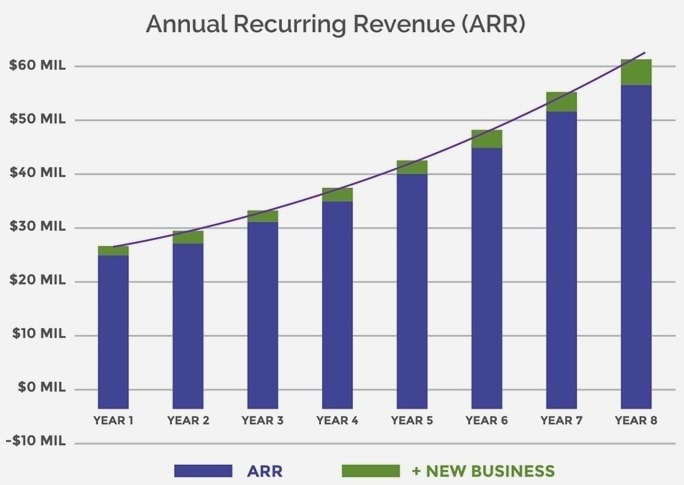
If you want to stay in business, you can’t focus solely on closing new deals and bagging new logos. The bulk of recurring revenue for many companies comes from keeping customers, not recruiting new ones. That means your success depends on building great relationships with new customers from day one.
Current customers account for 33-50% of total revenue growth, even at startups, McKinsey & Company has found. Some companies even find their installed customer base brings in up to 80% of their revenue.
For subscription-based businesses, the longer you’re around, the more of your revenue shifts to recurring revenue from your installed base—if you’re doing everything right.
The following figure depicts how the bulk of revenue comes from current customers, whereas new business revenue is like the icing on top of the cake.
Of course, it takes time to build to this state, which is why you need to nurture current customers right from the start. Otherwise, you’ll never keep all those customers paying you year after year.
The investment pays off, though, because as little as a 5% increase in customer retention produces more than a 25% percent increase in profits.
The beginning of a customer relationship determines its outcome
As you know, sales reps are great at building relationships with buyers. Trusting relationships are a huge component of a buyer’s decision, and the messages buyers receive during the sales journey influences how their customer journey begins.
Unfortunately, most companies dump all that relationship collateral down the drain when they win the deal.
Post-sales teams waste precious time understanding what was sold and what customers’ goals are. Customer teams are often unprepared, resistant, and even unaware. New customers become frustrated when they have to tell every person they talk to the same details about their objectives. As a consequence, deadlines are missed, internal teams are swamped and exasperated, and customers pause or even cancel their licenses before they ever go live with your product.
Those costs add up to thousands (or even millions) of dollars each year, including the labor costs of delayed implementations, paused and canceled subscriptions, and lost opportunities when sales teams are looped in to resolve issues with already-closed deals. The margins from new logos can erode quickly.
So, how can you start with new customers so they renew rather than churn?
To set you, your teams, and your customers up for success throughout the customer journey, follow these three steps to quickly build trusting, strong customer relationships.
1. Provide continuity
Repeating the same thing over and over to multiple people is no way to start a new relationship. Customers tell me how frustrating it is to recount the same information with the pre-sales team, the onboarding team, the customer success team, and the support or customer service team.
Instead, provide continuity. Continuity helps people build trust and get on board with what’s next.
Start by aligning your pre-sales and post-sales teams with an internal handoff before the customer handoff or kickoff. If you do, you’ll sustain the momentum gained from the sale, load your customer success manager or account owner with the information your new customer entrusted to sales reps, and give your customers a seamless and positive customer experience.
2. Connect with people
Although it may seem trivial, small talk is an invaluable tool for building customer relationships. So, take a few moments when you first meet with new customers to connect to the real people purchasing and using your product. Ask about their families, upcoming vacations, and weekend plans.
I prepare for meetings by investigating LinkedIn for shared connections or interests: where people live, where they went to school, and the activities they enjoy. Then I use that information to get the conversation started.
For example, in preparing for a recent meeting, I noticed my contact’s LinkedIn profile showed an image of him hanging out on the top of Half Dome, the legendary granite dome in the east end of Yosemite Valley. Since I had also hiked Half Dome, I started the conversation by discussing our shared experience.
Successful customer engagement can be as simple as that.
3. Show the path to success
When you throw long task lists and complicated requirements at new customers, they can’t process the information. They go into cognitive overload. Because the human brain processes visuals faster than text, you’ll build more trust by communicating with visuals.
Share images of the journey you and your customer are on together. It helps people process where they are, where they’ve been, and where they’re going in their work with you. Their brains will be thankful and more relaxed.
—
Guest Author: Donna Weber
This article first appeared in www.marketingprofs.com
Seeking to build and grow your brand using the force of consumer insight, strategic foresight, creative disruption and technology prowess? Talk to us at +971 50 6254340 or engage@groupisd.com or visit www.groupisd.com/story
